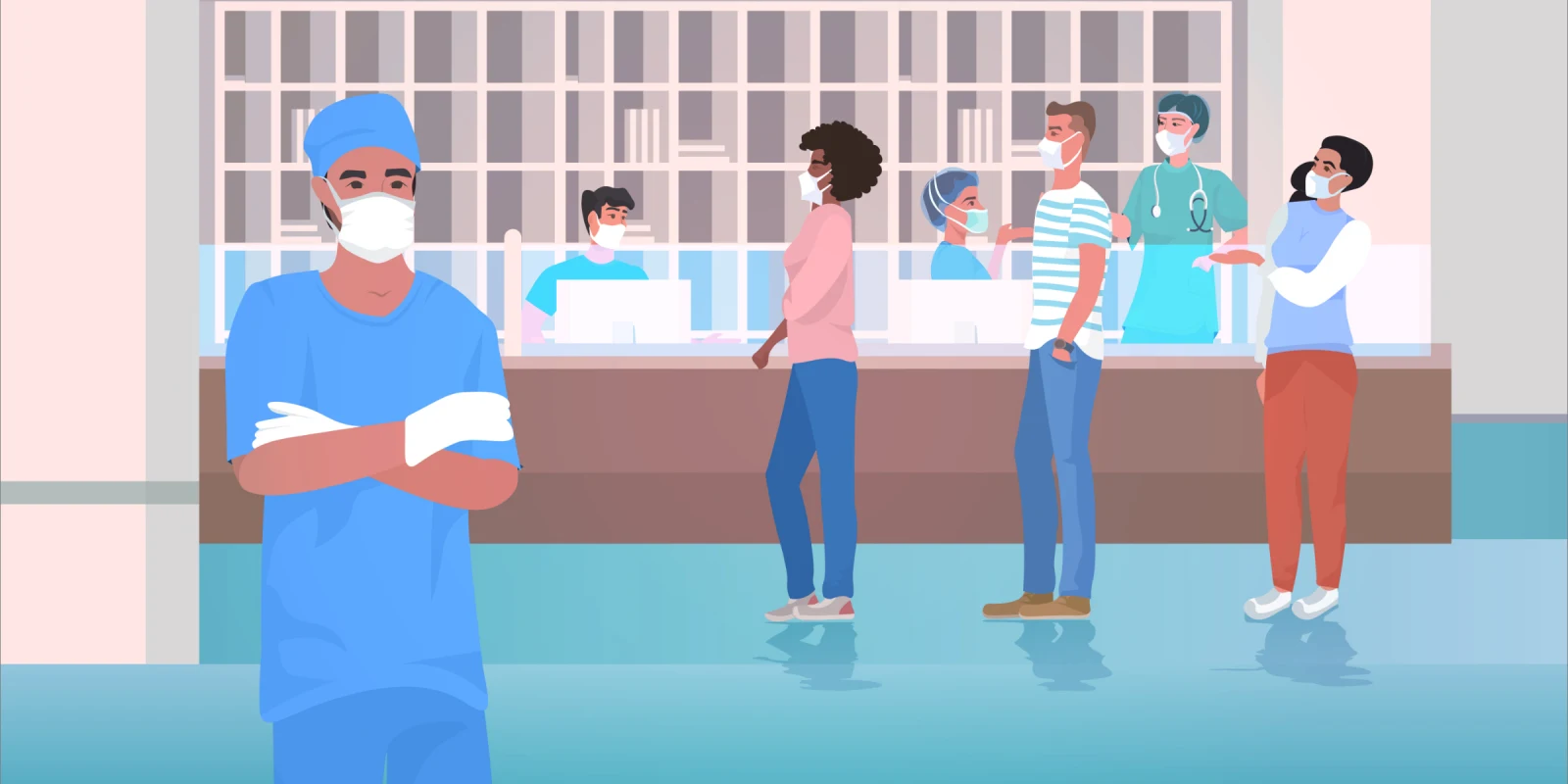
The COVID-19 pandemic has introduced many new obstacles to physicians who own, manage, and work in private practice.
Doximity recently surveyed physician users on our network about the current state of their practice, from gaps in information they’ve received about COVID-19 to how the pandemic has changed (and will continue to change) their professional lives. The survey received 109 responses from physicians who own or work in private practice across clinical specialties and settings.
When asked what they considered doing with their private practice during the COVID-19 pandemic, 18% of respondents said they considered closing their practice temporarily and/or postponing patient appointments. The majority of those surveyed, over 86% of clinicians, wanted to keep their practices open, but planned to give increased attention to guidelines and safety measures (e.g., increased use of telemedicine). About 12% of respondents said they were considering permanently closing their practice, or permanently leaving the practice in which they work.
Many physicians have voiced disappointment in the lack of assistance and guidance from local, state, and federal governments. “I need some engagement from local government agencies,” wrote Stephanie Taylor, MD, PhD. “They assume that the medical delivery system will always be there, like a public utility. They need to become educated about medical practice and support a variety of physician practice models, not just the large corporate practices.” Taylor cited an 83% loss of income due to patients not seeking preventative medical care, a major focus of her practice, and expressed that patients need to be active participants in their care by advocating for their physicians. “The ideal outcome for my practice would be increased engagement of my patients in the well-being and survival of my community-based medical practice,” she said, “which, in turn, benefits my local community.”
Ultimately, many physicians have been forced to make difficult decisions. More than 9% of respondents have temporarily closed or left their practice, and about 1% have permanently closed or left. Still, the majority of respondents (about 87%) said they are remaining open for business, but with some changes in operation. Interestingly, 50% of those who have temporarily closed are ophthalmology practices. The only reported permanent closure was a pediatrics practice.
Doximity members also shared their most pressing concerns for maintaining their practice during the pandemic. There were several revealing commonalities in respondents’ questions and needs; many asked: How can I get the funds to stay in business? How can I obtain proper PPE? What will the “new normal” be?
Financial hardship and uncertainty regarding the future of practice is at the forefront of many physicians’ minds; about one-fifth of survey respondents said they have financial concerns, have seen a significant loss in revenue, or have struggled to maintain patient census week-to-week because of stay-at-home orders, fear, and staff shortages. “I feel it is impossible to calculate numbers based on numerous unknowns,” wrote Samuel L. Gettler, MD, dermatologist. “The timing of the reopening of our economy is unclear, patients’ willingness to leave their homes without a vaccine or known active treatment is unclear, and patients’ permanently altered opinions that telemedicine can replace in-office medicine will all negatively impact the ability of private practice to resume as before.”
Some physicians (about 13% of respondents) cited struggles with implementing telemedicine and getting the proper reimbursement, and some had trouble getting patients onboard because of technical difficulties. Many of the physicians surveyed are worried that their reimbursements for telemedicine appointments will not be equal to in-person rates, or that the rates implemented by CMS will not be in effect for the full duration of the social and cultural changes brought about by the pandemic. “Adaptability is key,” wrote Stephen Reidbord, MD, psychiatrist. “I was opposed to online/virtual therapy before the pandemic; now I use it almost exclusively. We must be flexible and compromise. I hope to return to in-person office practice as soon as it's safe. Adaptability doesn't mean abandoning high clinical and ethical standards when we can return to them.”
Additionally, a steady undercurrent of anxiety over PPE and the availability of not only traditional PPE, but the availability of COVID-19 testing and clear, concise information on infection and treatment. Nearly one-fifth of Doximity respondents said they were concerned about the ability to perform COVID-19 testing in their offices, especially for their staff, and about how to protect their staff and themselves from transmission. In conjunction with COVID-19 concerns, one-fifth of respondents also cited the need for clearer guidelines on how and when they can safely reopen their practices and return to seeing patients in-office. A sharper focus on sanitation and infection prevention is also of concern.
“Use telemedicine and charge properly for it. Be innovative on how to see patients virtually, and safely,” advised Jeanne Novas, MD, FACOG. Novas suggests keeping in virtual contact with patients, informing them of updates to local recommendations and being “one step ahead” in offering services. “Keep your practice safe with screening, masks, social distancing, and having an ‘a’ and ‘b’ team in case someone gets sick,” she added. “Educate your patients and your staff. Some patients will really need you to guide them. Be there for them. Make yourself available.”
In the following text, you will find a list of commonly asked questions from Doximity users and our responses with current strategies and guidelines for addressing these various concerns. Please refer to the list of resources at the bottom of the page for further reading on key issues like financial assistance, telemedicine reimbursement, and current guidelines for maintaining and reopening practices across specialties.
How can I keep my facility clean and safe for myself, my staff, and my patients as we reopen or resume regular care?
The AMA has published a comprehensive resources sheet for clinicians in all health care settings who are seeking further information about sanitization, infection control, and supply management. The sheet includes links to critically important CDC guideline documents, including “Interim U.S. Guidance for Risk Assessment and Public Health Management of Healthcare Personnel with Potential Exposure in a Healthcare Setting to Patients with Coronavirus Disease 2019 (COVID-19).” This page explains what is currently known about the viral transmission of COVID-19, how to manage exposure for you and your staff, and how to determine your risk. It also gives proper PPE guidelines for treatment settings, and discusses what to do if you or an employee develops symptoms.
Additionally, the AMA cites the CMS guidelines on continuing to treat patients during the pandemic. CMS advises that elective and procedural cases be postponed, with appropriate consideration for cases in which the risk of postponement would outweigh the benefits. Practices that treat specific patient populations (such as pediatric practices) will have slightly different guidelines.
The AMA has also published a physician guide for reopening your practice after pandemic-related closure, which includes strategies for pre-screening, staff management, safety measures, and governmental guidance.
The CDC frequently updates information for health care professionals regarding PPE and supply management. Clinicians can also stay up to date with current guidelines on evaluating and testing for COVID-19 on the CDC website.
How can I receive appropriate reimbursement for telemedicine services?
CMS has recently broadened access to telemedicine reimbursement services for clinicians in all settings and areas of the country, beginning with services rendered on March 6, 2020 and extending throughout the COVID-19 public health emergency. Codes for a wide range of telemedicine services, including phone check-ins, audio/visual interactions, and evaluations of recorded video/audio from patients can be found on the Medicare Telemedicine Fact Sheet. Detailed instructions for billing, coding, and reimbursement can be found in this CMS online instructional booklet, published in March.
If you are billing private insurance as opposed to CMS, alternative coding and reimbursement policies may exist, but most major private insurance does cover telemedicine appointments and reimburse at in-office rates. Always check with a patient’s insurance company to confirm telemedicine appointments will be reimbursed, and at appropriate rates. The AMA has drafted this Telehealth Implementation Playbook for billing private insurance companies for telemedicine.
How can I receive financial assistance for my practice?
The American College of Cardiology recently published additional updates on financial assistance for eligible clinicians, including direct deposit payments to clinicians from the HHS CARES Act Provider Relief Fund. General distribution began April 10, 2020 and recipients must have confirmed their eligibility and receipt of funds within 30 days on the CARES Provider Relief Fund Payment Portal. Clinicians who either did not receive a payment from the first distribution, or are seeking additional relief funds, can complete an additional CARES application to receive part of the second distribution, which began on April 24. Further information on how to access the application portal and who to contact for reimbursement questions can be found on the AMA fact sheet.
Additionally, clinicians who conducted COVID-19 testing or provided treatment for uninsured patients with COVID-19 beginning on or after February 4, 2020 can request claims reimbursement at Medicare rates.
Clinicians who are not eligible for assistance under the CARES Act can apply for a Payroll Protection Program (PPP) loan from the U.S. Small Business Administration, as well as an Economic Injury Disaster Loan (EIDL) for practices with no more than 500 employees. A practice can qualify for both a PPP and EIDL loan at the same time, as long as they are not being used for the same types of expenses. Further information on small business loans, debt relief programs, and emergency funds can be found on this guide sheet from the AMA.
Andrew Hurst, MD, offers this advice for fellow Doximity physicians: “This too shall pass. Be kind to your staff. Be up front and honest with staff about the finances so they don’t assume worst case scenario. Cut the budget at work and at home as much as possible. Use this down time to exercise and accomplish other goals that you were too busy for before the slowdown.”
Resources for telemedicine and reimbursement:
- Medicare Telemedicine Health Care Provider Fact Sheet - CMS
- Teleheath Services Medicare Learning Network Booklet - CMS
- AMA Quick Guide to Telemedicine in Practice - AMA
- Telehealth Implementation Playbook - AMA
Resources for financial assistance:
- 97% of practices feel COVID-19 financial sting: Where to get help - AMA
- How doctors can claim share of additional $20 billion in CARES Act aid - AMA
- Coronavirus (COVID-19): Small Business Guidance & Loan Resources - U.S. Small Business Administration
- COVID-19 Economic Injury Disaster Loan Application - U.S. Small Business Administration
- CARES Act/COVID 3.5: Loans & other financial assistance for physician practices - AMA
- CARES Act Provider Relief Fund - HHS
- Fact sheet: Provider Relief Fund second general distribution - AMA
Resources for PPE, COVID-19 transmission, and safety guidelines:
- Interim U.S. Guidance for Risk Assessment and Public Health Management of Healthcare Personnel with Potential Exposure in a Healthcare Setting to Patients with Coronavirus Disease 2019 (COVID-19) - CDC
- A Physician’s Guide to COVID-19 - AMA
- Evaluating and Testing Persons for Coronavirus Disease 2019 (COVID-19) - CDC
- Strategies to Optimize the Supply of PPE and Equipment - CDC






